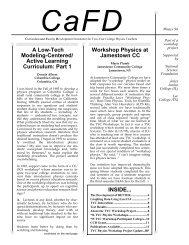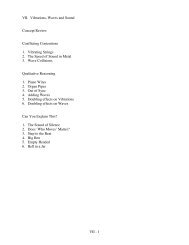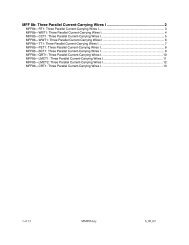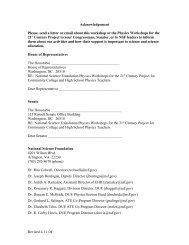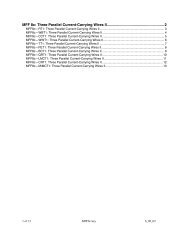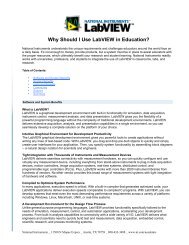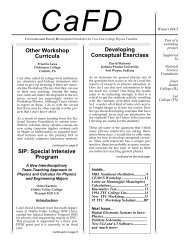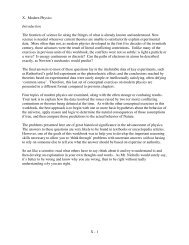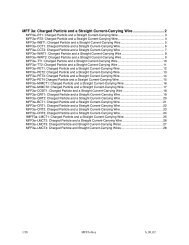III - 1 II. Newton's Laws of Motion Concept Review Warm-Up ...
III - 1 II. Newton's Laws of Motion Concept Review Warm-Up ...
III - 1 II. Newton's Laws of Motion Concept Review Warm-Up ...
You also want an ePaper? Increase the reach of your titles
YUMPU automatically turns print PDFs into web optimized ePapers that Google loves.
QUALITATIVE REASONING<br />
General Hint: For both the Qualitative Reasoning questions and Can You Explain This<br />
exercises, first consider which <strong>of</strong> Newton’s three laws should be applied to explain each<br />
particular situation before determining the correct answer to the problem.<br />
1. Car Push<br />
A truck has broken down on the side <strong>of</strong> the road and the owner <strong>of</strong> a small compact car is willing<br />
to help out. He nudges up to the truck’s bumper and begins pushing the truck down the highway.<br />
How does the force <strong>of</strong> the car acting on the truck compare to the force <strong>of</strong> the truck acting on the<br />
car:<br />
a. When the car and the truck are accelerating<br />
b. When the car and the truck are traveling at a constant velocity<br />
2. Moving Elevator<br />
Consider an elevator first accelerating upward from rest, then traveling at a constant velocity,<br />
and finally slowing down to a stop at one <strong>of</strong> the upper floors <strong>of</strong> a building. There are two forces<br />
acting on the elevator: the weight <strong>of</strong> the elevator and the tension in the cable attached to it.<br />
How do the magnitudes <strong>of</strong> these two forces compare:<br />
a. When the elevator is accelerating upward,<br />
b. When the elevator is moving at a constant velocity,<br />
c. And when the elevator is slowing down to a stop<br />
Now suppose the elevator makes the return trip to where it started from. How would the tension<br />
and weight magnitudes compare for each leg <strong>of</strong> the journey downward<br />
3. Second and Third Law Pairs<br />
A book is resting on a table. There are two forces acting on the book: the weight <strong>of</strong> the book<br />
pointing downward, and a ‘normal force’ caused by the table top, pointing upward.<br />
These two forces are equal in magnitude and opposite in direction, but this is not an example <strong>of</strong><br />
Newton’s Third Law <strong>of</strong> <strong>Motion</strong>. These forces are equal and opposite because the book is not<br />
accelerating: it is at rest. This is an application <strong>of</strong> Newton’s Second Law <strong>of</strong> <strong>Motion</strong>!<br />
a. What is the correct ‘third law pair’ reaction force for the normal force pushing up on the<br />
book<br />
<strong><strong>II</strong>I</strong> - 7



